CQUniversity Australia: Consolidated Portfolio Project Negotiation
VerifiedAdded on 2023/06/11
|9
|2810
|167
Portfolio
AI Summary
This consolidated portfolio presents a comprehensive overview of the student's learning journey in commercial project negotiation at CQUniversity Australia. It includes an introduction and summary of outcomes, followed by an itemization of each learning outcome (LO1-LO6) with summaries and evidence from weekly modules. The evidence highlights the student's understanding and application of concepts such as contract arrangements, dispute resolution, stakeholder management, conflict management, and project management tools. The portfolio demonstrates the student's ability to describe complex projects, evaluate arguments, resolve conflicts, identify the impact of project delays, and apply various project management tools. The discussion and conclusion reflect on the student's personal and professional growth, emphasizing the practical application of learned skills and the development of improved communication and negotiation abilities. The portfolio concludes with references and an appendix of weekly module summaries.

1
Consolidated Portfolio
Student Name:
Student Number:
Module Code:
Submission Date:
Consolidated Portfolio
Student Name:
Student Number:
Module Code:
Submission Date:
Paraphrase This Document
Need a fresh take? Get an instant paraphrase of this document with our AI Paraphraser

2
1. Introduction and summary of outcomes
While studying at CQUniversity Australia this year, I got an opportunity to register
for a unit in commercial project negotiation. I have achieved several goals that I had
developed some negative attitude on how I could attain them. Most importantly, I have
managed to gain cognitive, technical and creative skills, conduct independent research, and
take ethical and professional responsibility in my previous work (Khaitan, 2016). Besides,
after going three 11 weeks module, I can confidently say that I have managed to not only
understand but also practise four key outcomes of this course. According to the outcome of
the course, I now have the ability to describe complex projects, use logic to evaluate
arguments and resolve conflicts, and identify differences conflict management and
engagement with different stakeholders (PMI, 2013). Furthermore, I can explain the impact
of delays in projects and evaluate possible tools to assist in project management.
2. Itemisation of each learning Outcome
LO1
i. Summary
The first learning outcome targeted at making me gain a deeper understanding on
ways that I could operate within diverse and complex projects initiated by either a
government or non-governmental organization. Most importantly, the key areas of focus were
to understand arrangement of contracts important for ICT, agreements, and managed services.
ii. Evidence
Both the client and the project manager are immensely affected by variations, arbitration,
claims, and disputes. There is a necessity for the project manager to avoid getting involved in
disputes with customers since it would destroy firm’s public image (Aibinu and Jagboro,
2002). Stubborn clients also have an adverse impact on the organization since they make
1. Introduction and summary of outcomes
While studying at CQUniversity Australia this year, I got an opportunity to register
for a unit in commercial project negotiation. I have achieved several goals that I had
developed some negative attitude on how I could attain them. Most importantly, I have
managed to gain cognitive, technical and creative skills, conduct independent research, and
take ethical and professional responsibility in my previous work (Khaitan, 2016). Besides,
after going three 11 weeks module, I can confidently say that I have managed to not only
understand but also practise four key outcomes of this course. According to the outcome of
the course, I now have the ability to describe complex projects, use logic to evaluate
arguments and resolve conflicts, and identify differences conflict management and
engagement with different stakeholders (PMI, 2013). Furthermore, I can explain the impact
of delays in projects and evaluate possible tools to assist in project management.
2. Itemisation of each learning Outcome
LO1
i. Summary
The first learning outcome targeted at making me gain a deeper understanding on
ways that I could operate within diverse and complex projects initiated by either a
government or non-governmental organization. Most importantly, the key areas of focus were
to understand arrangement of contracts important for ICT, agreements, and managed services.
ii. Evidence
Both the client and the project manager are immensely affected by variations, arbitration,
claims, and disputes. There is a necessity for the project manager to avoid getting involved in
disputes with customers since it would destroy firm’s public image (Aibinu and Jagboro,
2002). Stubborn clients also have an adverse impact on the organization since they make
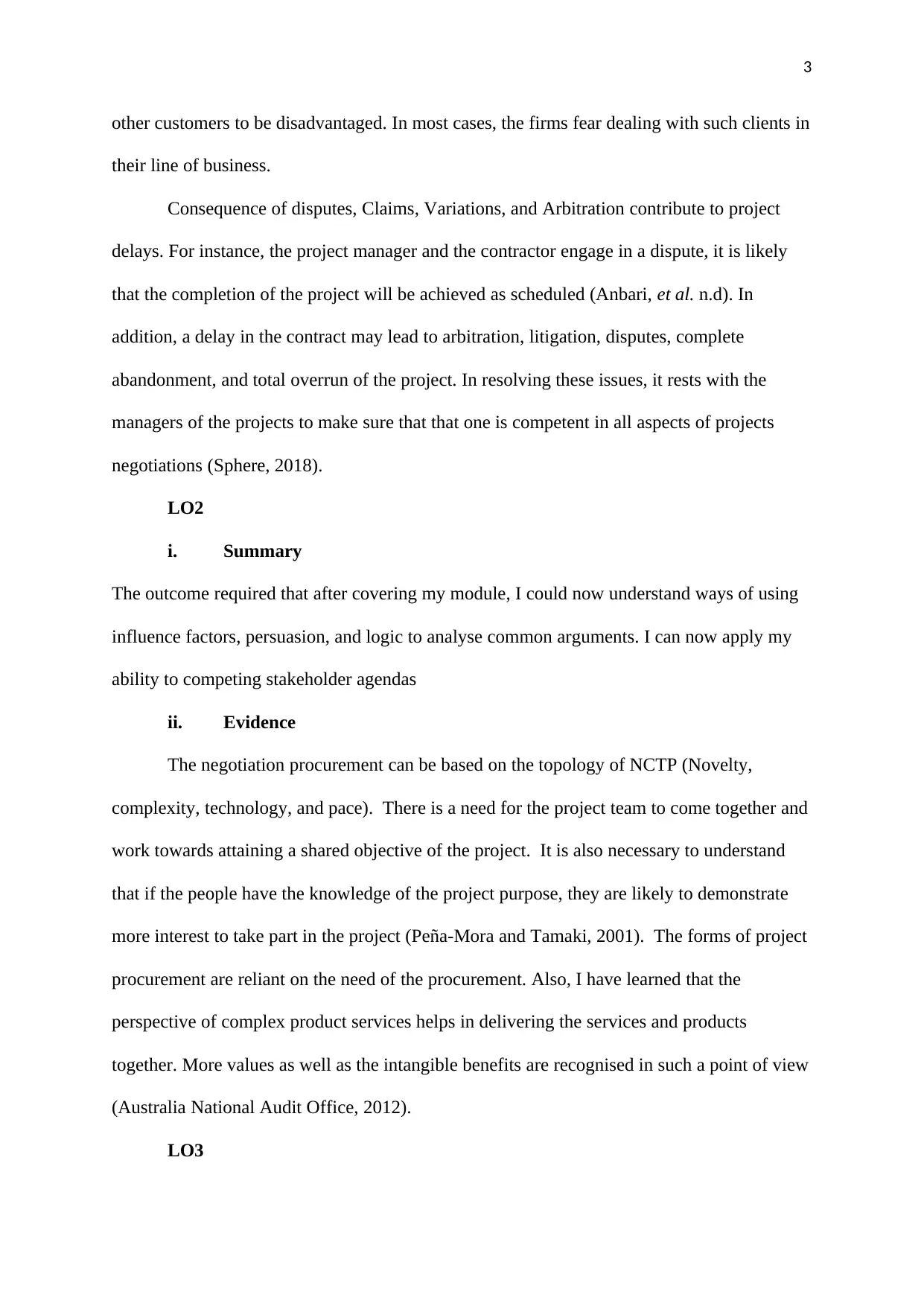
3
other customers to be disadvantaged. In most cases, the firms fear dealing with such clients in
their line of business.
Consequence of disputes, Claims, Variations, and Arbitration contribute to project
delays. For instance, the project manager and the contractor engage in a dispute, it is likely
that the completion of the project will be achieved as scheduled (Anbari, et al. n.d). In
addition, a delay in the contract may lead to arbitration, litigation, disputes, complete
abandonment, and total overrun of the project. In resolving these issues, it rests with the
managers of the projects to make sure that that one is competent in all aspects of projects
negotiations (Sphere, 2018).
LO2
i. Summary
The outcome required that after covering my module, I could now understand ways of using
influence factors, persuasion, and logic to analyse common arguments. I can now apply my
ability to competing stakeholder agendas
ii. Evidence
The negotiation procurement can be based on the topology of NCTP (Novelty,
complexity, technology, and pace). There is a need for the project team to come together and
work towards attaining a shared objective of the project. It is also necessary to understand
that if the people have the knowledge of the project purpose, they are likely to demonstrate
more interest to take part in the project (Peña-Mora and Tamaki, 2001). The forms of project
procurement are reliant on the need of the procurement. Also, I have learned that the
perspective of complex product services helps in delivering the services and products
together. More values as well as the intangible benefits are recognised in such a point of view
(Australia National Audit Office, 2012).
LO3
other customers to be disadvantaged. In most cases, the firms fear dealing with such clients in
their line of business.
Consequence of disputes, Claims, Variations, and Arbitration contribute to project
delays. For instance, the project manager and the contractor engage in a dispute, it is likely
that the completion of the project will be achieved as scheduled (Anbari, et al. n.d). In
addition, a delay in the contract may lead to arbitration, litigation, disputes, complete
abandonment, and total overrun of the project. In resolving these issues, it rests with the
managers of the projects to make sure that that one is competent in all aspects of projects
negotiations (Sphere, 2018).
LO2
i. Summary
The outcome required that after covering my module, I could now understand ways of using
influence factors, persuasion, and logic to analyse common arguments. I can now apply my
ability to competing stakeholder agendas
ii. Evidence
The negotiation procurement can be based on the topology of NCTP (Novelty,
complexity, technology, and pace). There is a need for the project team to come together and
work towards attaining a shared objective of the project. It is also necessary to understand
that if the people have the knowledge of the project purpose, they are likely to demonstrate
more interest to take part in the project (Peña-Mora and Tamaki, 2001). The forms of project
procurement are reliant on the need of the procurement. Also, I have learned that the
perspective of complex product services helps in delivering the services and products
together. More values as well as the intangible benefits are recognised in such a point of view
(Australia National Audit Office, 2012).
LO3
⊘ This is a preview!⊘
Do you want full access?
Subscribe today to unlock all pages.

Trusted by 1+ million students worldwide
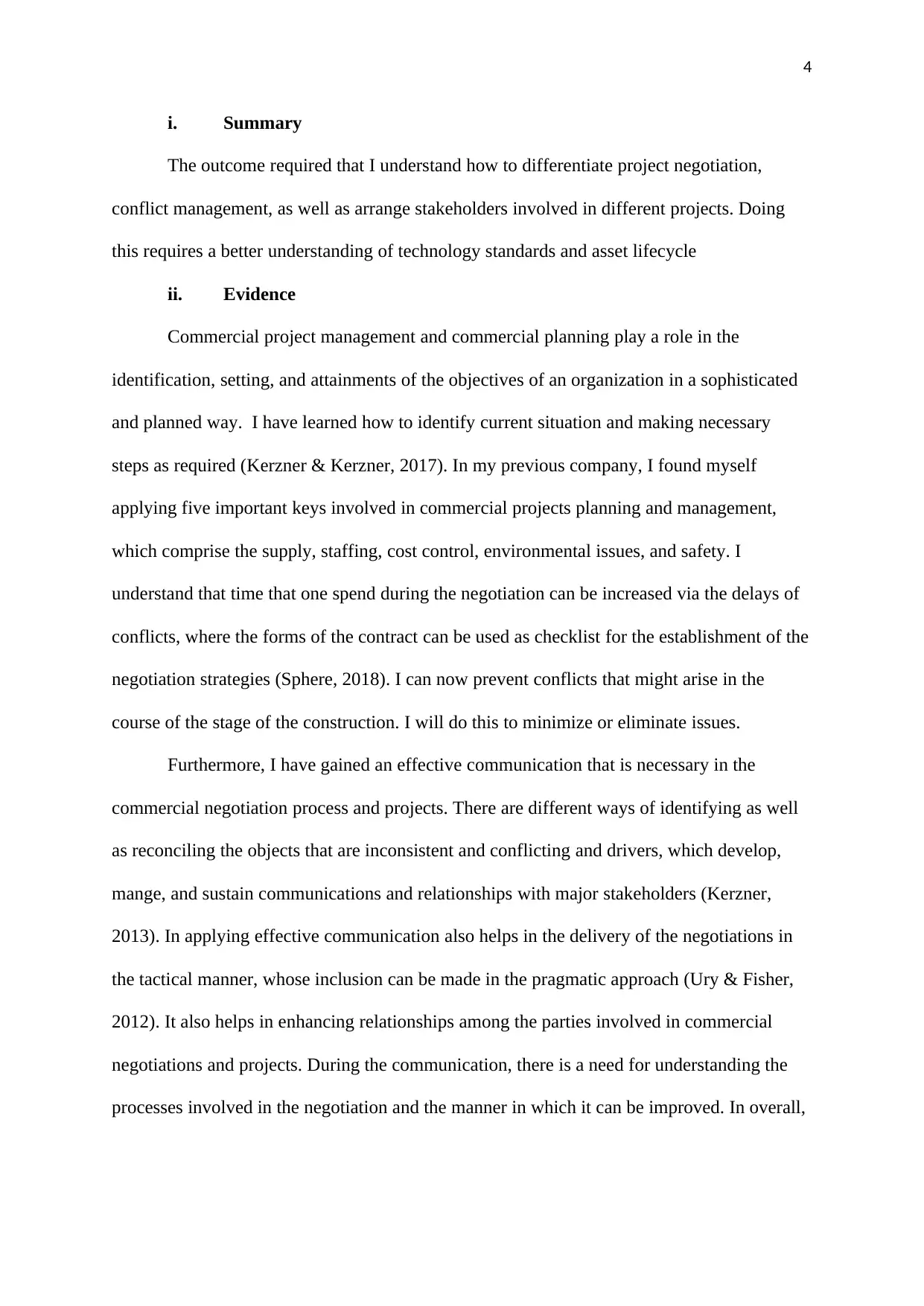
4
i. Summary
The outcome required that I understand how to differentiate project negotiation,
conflict management, as well as arrange stakeholders involved in different projects. Doing
this requires a better understanding of technology standards and asset lifecycle
ii. Evidence
Commercial project management and commercial planning play a role in the
identification, setting, and attainments of the objectives of an organization in a sophisticated
and planned way. I have learned how to identify current situation and making necessary
steps as required (Kerzner & Kerzner, 2017). In my previous company, I found myself
applying five important keys involved in commercial projects planning and management,
which comprise the supply, staffing, cost control, environmental issues, and safety. I
understand that time that one spend during the negotiation can be increased via the delays of
conflicts, where the forms of the contract can be used as checklist for the establishment of the
negotiation strategies (Sphere, 2018). I can now prevent conflicts that might arise in the
course of the stage of the construction. I will do this to minimize or eliminate issues.
Furthermore, I have gained an effective communication that is necessary in the
commercial negotiation process and projects. There are different ways of identifying as well
as reconciling the objects that are inconsistent and conflicting and drivers, which develop,
mange, and sustain communications and relationships with major stakeholders (Kerzner,
2013). In applying effective communication also helps in the delivery of the negotiations in
the tactical manner, whose inclusion can be made in the pragmatic approach (Ury & Fisher,
2012). It also helps in enhancing relationships among the parties involved in commercial
negotiations and projects. During the communication, there is a need for understanding the
processes involved in the negotiation and the manner in which it can be improved. In overall,
i. Summary
The outcome required that I understand how to differentiate project negotiation,
conflict management, as well as arrange stakeholders involved in different projects. Doing
this requires a better understanding of technology standards and asset lifecycle
ii. Evidence
Commercial project management and commercial planning play a role in the
identification, setting, and attainments of the objectives of an organization in a sophisticated
and planned way. I have learned how to identify current situation and making necessary
steps as required (Kerzner & Kerzner, 2017). In my previous company, I found myself
applying five important keys involved in commercial projects planning and management,
which comprise the supply, staffing, cost control, environmental issues, and safety. I
understand that time that one spend during the negotiation can be increased via the delays of
conflicts, where the forms of the contract can be used as checklist for the establishment of the
negotiation strategies (Sphere, 2018). I can now prevent conflicts that might arise in the
course of the stage of the construction. I will do this to minimize or eliminate issues.
Furthermore, I have gained an effective communication that is necessary in the
commercial negotiation process and projects. There are different ways of identifying as well
as reconciling the objects that are inconsistent and conflicting and drivers, which develop,
mange, and sustain communications and relationships with major stakeholders (Kerzner,
2013). In applying effective communication also helps in the delivery of the negotiations in
the tactical manner, whose inclusion can be made in the pragmatic approach (Ury & Fisher,
2012). It also helps in enhancing relationships among the parties involved in commercial
negotiations and projects. During the communication, there is a need for understanding the
processes involved in the negotiation and the manner in which it can be improved. In overall,
Paraphrase This Document
Need a fresh take? Get an instant paraphrase of this document with our AI Paraphraser
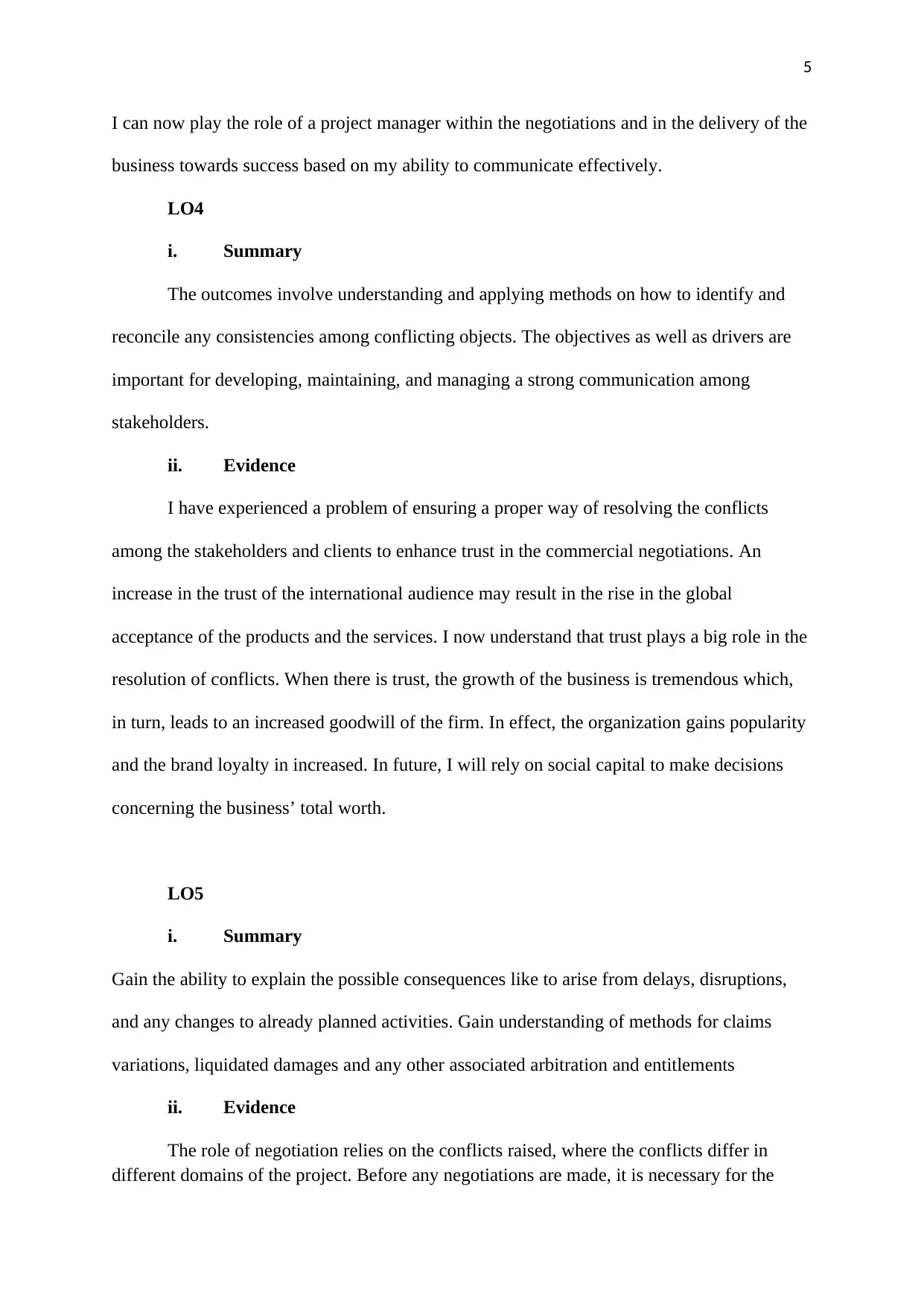
5
I can now play the role of a project manager within the negotiations and in the delivery of the
business towards success based on my ability to communicate effectively.
LO4
i. Summary
The outcomes involve understanding and applying methods on how to identify and
reconcile any consistencies among conflicting objects. The objectives as well as drivers are
important for developing, maintaining, and managing a strong communication among
stakeholders.
ii. Evidence
I have experienced a problem of ensuring a proper way of resolving the conflicts
among the stakeholders and clients to enhance trust in the commercial negotiations. An
increase in the trust of the international audience may result in the rise in the global
acceptance of the products and the services. I now understand that trust plays a big role in the
resolution of conflicts. When there is trust, the growth of the business is tremendous which,
in turn, leads to an increased goodwill of the firm. In effect, the organization gains popularity
and the brand loyalty in increased. In future, I will rely on social capital to make decisions
concerning the business’ total worth.
LO5
i. Summary
Gain the ability to explain the possible consequences like to arise from delays, disruptions,
and any changes to already planned activities. Gain understanding of methods for claims
variations, liquidated damages and any other associated arbitration and entitlements
ii. Evidence
The role of negotiation relies on the conflicts raised, where the conflicts differ in
different domains of the project. Before any negotiations are made, it is necessary for the
I can now play the role of a project manager within the negotiations and in the delivery of the
business towards success based on my ability to communicate effectively.
LO4
i. Summary
The outcomes involve understanding and applying methods on how to identify and
reconcile any consistencies among conflicting objects. The objectives as well as drivers are
important for developing, maintaining, and managing a strong communication among
stakeholders.
ii. Evidence
I have experienced a problem of ensuring a proper way of resolving the conflicts
among the stakeholders and clients to enhance trust in the commercial negotiations. An
increase in the trust of the international audience may result in the rise in the global
acceptance of the products and the services. I now understand that trust plays a big role in the
resolution of conflicts. When there is trust, the growth of the business is tremendous which,
in turn, leads to an increased goodwill of the firm. In effect, the organization gains popularity
and the brand loyalty in increased. In future, I will rely on social capital to make decisions
concerning the business’ total worth.
LO5
i. Summary
Gain the ability to explain the possible consequences like to arise from delays, disruptions,
and any changes to already planned activities. Gain understanding of methods for claims
variations, liquidated damages and any other associated arbitration and entitlements
ii. Evidence
The role of negotiation relies on the conflicts raised, where the conflicts differ in
different domains of the project. Before any negotiations are made, it is necessary for the

6
project manager to consult with the key stakeholders, projects team, and clients to realize the
effective outcomes. Proper project planning is needed to ensure it is done effectively and
accomplished in the stipulated timeframe. Also, I gained insight concerning the reasons for
the occurrence of the conflicts. It may because of levels of resources; uncertainty levels in the
objectives of the project, separating, and rewards.
LO6
i. Summary
Gain the ability to evaluate different project management tools in order to avoid and resolve
conflict through various negotiation solutions.
ii. Evidence
I have gained a comprehensive understanding of the aspects of rebalancing,
diversification, asset allocation, return on investment calculations, evaluation of the capital
budget, equivalent annual cost comparison as applied to project management frameworks and
standards. Any changes the standards and frameworks may reflect the overall delivery of the
project negatively or positively. Thus, there is a need of for the project to be manipulative or
have acceptable changes to ensure that the deliveries fulfil the project outputs and goals.
Diversification plays a substantial role in the management of the project. It refers to
the technique, which makes it possible for the manager to examine the project and analyse the
best solution that is appropriate for the portfolio management. Importantly, diversifying the
activities in the project management is important for the effectiveness of the standards and
frameworks employed.
3. Discussion and Conclusion
At the time of undertaking my course, I started thinking about the idea of how I could
apply all the learning outcomes. I can confidently say that I am grateful for having signed for
this course and the far that I have managed to come. This is because I have succeeded in
gaining skills and knowledge that I had not gained before starting this course. Furthermore, it
is imperative to point out that I am currently my future profession of not only becoming a
good project manager, but also a good leader. In my first week for instance, I gained an
introduction to commercial projects and types of negotiations that occurs within such
complex projects. Commercial planning depends on several processes to help define the
project manager to consult with the key stakeholders, projects team, and clients to realize the
effective outcomes. Proper project planning is needed to ensure it is done effectively and
accomplished in the stipulated timeframe. Also, I gained insight concerning the reasons for
the occurrence of the conflicts. It may because of levels of resources; uncertainty levels in the
objectives of the project, separating, and rewards.
LO6
i. Summary
Gain the ability to evaluate different project management tools in order to avoid and resolve
conflict through various negotiation solutions.
ii. Evidence
I have gained a comprehensive understanding of the aspects of rebalancing,
diversification, asset allocation, return on investment calculations, evaluation of the capital
budget, equivalent annual cost comparison as applied to project management frameworks and
standards. Any changes the standards and frameworks may reflect the overall delivery of the
project negatively or positively. Thus, there is a need of for the project to be manipulative or
have acceptable changes to ensure that the deliveries fulfil the project outputs and goals.
Diversification plays a substantial role in the management of the project. It refers to
the technique, which makes it possible for the manager to examine the project and analyse the
best solution that is appropriate for the portfolio management. Importantly, diversifying the
activities in the project management is important for the effectiveness of the standards and
frameworks employed.
3. Discussion and Conclusion
At the time of undertaking my course, I started thinking about the idea of how I could
apply all the learning outcomes. I can confidently say that I am grateful for having signed for
this course and the far that I have managed to come. This is because I have succeeded in
gaining skills and knowledge that I had not gained before starting this course. Furthermore, it
is imperative to point out that I am currently my future profession of not only becoming a
good project manager, but also a good leader. In my first week for instance, I gained an
introduction to commercial projects and types of negotiations that occurs within such
complex projects. Commercial planning depends on several processes to help define the
⊘ This is a preview!⊘
Do you want full access?
Subscribe today to unlock all pages.

Trusted by 1+ million students worldwide
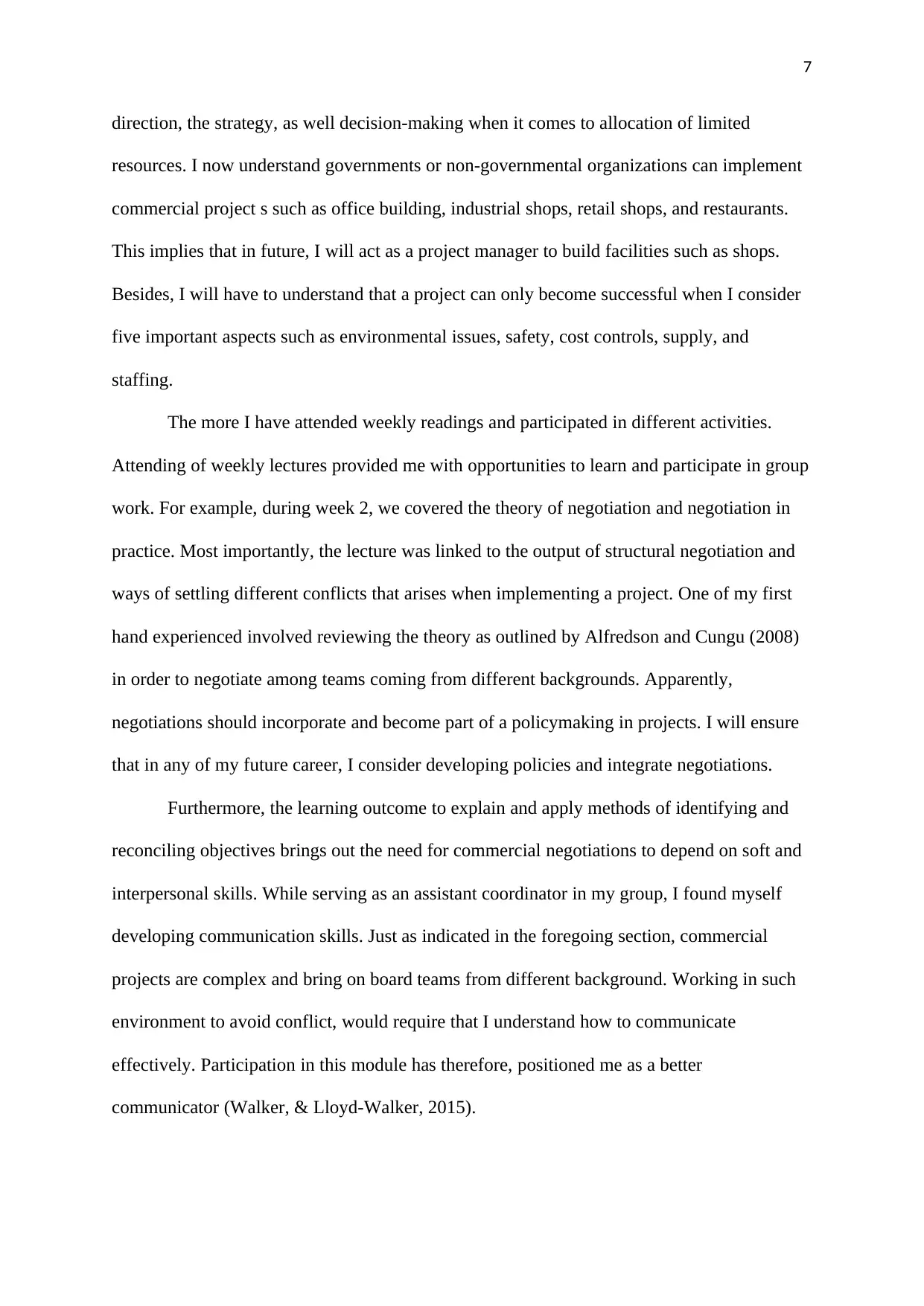
7
direction, the strategy, as well decision-making when it comes to allocation of limited
resources. I now understand governments or non-governmental organizations can implement
commercial project s such as office building, industrial shops, retail shops, and restaurants.
This implies that in future, I will act as a project manager to build facilities such as shops.
Besides, I will have to understand that a project can only become successful when I consider
five important aspects such as environmental issues, safety, cost controls, supply, and
staffing.
The more I have attended weekly readings and participated in different activities.
Attending of weekly lectures provided me with opportunities to learn and participate in group
work. For example, during week 2, we covered the theory of negotiation and negotiation in
practice. Most importantly, the lecture was linked to the output of structural negotiation and
ways of settling different conflicts that arises when implementing a project. One of my first
hand experienced involved reviewing the theory as outlined by Alfredson and Cungu (2008)
in order to negotiate among teams coming from different backgrounds. Apparently,
negotiations should incorporate and become part of a policymaking in projects. I will ensure
that in any of my future career, I consider developing policies and integrate negotiations.
Furthermore, the learning outcome to explain and apply methods of identifying and
reconciling objectives brings out the need for commercial negotiations to depend on soft and
interpersonal skills. While serving as an assistant coordinator in my group, I found myself
developing communication skills. Just as indicated in the foregoing section, commercial
projects are complex and bring on board teams from different background. Working in such
environment to avoid conflict, would require that I understand how to communicate
effectively. Participation in this module has therefore, positioned me as a better
communicator (Walker, & Lloyd-Walker, 2015).
direction, the strategy, as well decision-making when it comes to allocation of limited
resources. I now understand governments or non-governmental organizations can implement
commercial project s such as office building, industrial shops, retail shops, and restaurants.
This implies that in future, I will act as a project manager to build facilities such as shops.
Besides, I will have to understand that a project can only become successful when I consider
five important aspects such as environmental issues, safety, cost controls, supply, and
staffing.
The more I have attended weekly readings and participated in different activities.
Attending of weekly lectures provided me with opportunities to learn and participate in group
work. For example, during week 2, we covered the theory of negotiation and negotiation in
practice. Most importantly, the lecture was linked to the output of structural negotiation and
ways of settling different conflicts that arises when implementing a project. One of my first
hand experienced involved reviewing the theory as outlined by Alfredson and Cungu (2008)
in order to negotiate among teams coming from different backgrounds. Apparently,
negotiations should incorporate and become part of a policymaking in projects. I will ensure
that in any of my future career, I consider developing policies and integrate negotiations.
Furthermore, the learning outcome to explain and apply methods of identifying and
reconciling objectives brings out the need for commercial negotiations to depend on soft and
interpersonal skills. While serving as an assistant coordinator in my group, I found myself
developing communication skills. Just as indicated in the foregoing section, commercial
projects are complex and bring on board teams from different background. Working in such
environment to avoid conflict, would require that I understand how to communicate
effectively. Participation in this module has therefore, positioned me as a better
communicator (Walker, & Lloyd-Walker, 2015).
Paraphrase This Document
Need a fresh take? Get an instant paraphrase of this document with our AI Paraphraser
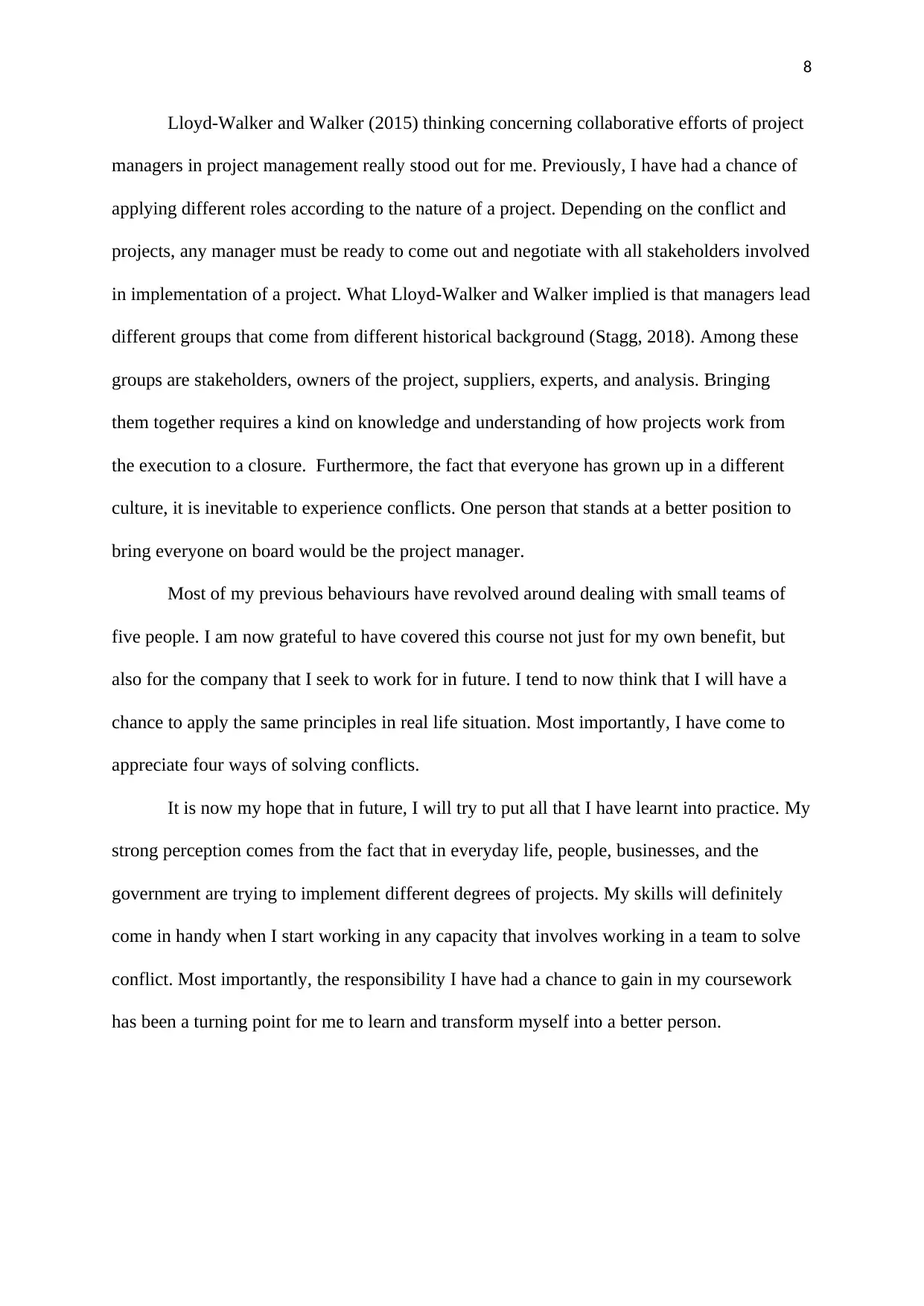
8
Lloyd-Walker and Walker (2015) thinking concerning collaborative efforts of project
managers in project management really stood out for me. Previously, I have had a chance of
applying different roles according to the nature of a project. Depending on the conflict and
projects, any manager must be ready to come out and negotiate with all stakeholders involved
in implementation of a project. What Lloyd-Walker and Walker implied is that managers lead
different groups that come from different historical background (Stagg, 2018). Among these
groups are stakeholders, owners of the project, suppliers, experts, and analysis. Bringing
them together requires a kind on knowledge and understanding of how projects work from
the execution to a closure. Furthermore, the fact that everyone has grown up in a different
culture, it is inevitable to experience conflicts. One person that stands at a better position to
bring everyone on board would be the project manager.
Most of my previous behaviours have revolved around dealing with small teams of
five people. I am now grateful to have covered this course not just for my own benefit, but
also for the company that I seek to work for in future. I tend to now think that I will have a
chance to apply the same principles in real life situation. Most importantly, I have come to
appreciate four ways of solving conflicts.
It is now my hope that in future, I will try to put all that I have learnt into practice. My
strong perception comes from the fact that in everyday life, people, businesses, and the
government are trying to implement different degrees of projects. My skills will definitely
come in handy when I start working in any capacity that involves working in a team to solve
conflict. Most importantly, the responsibility I have had a chance to gain in my coursework
has been a turning point for me to learn and transform myself into a better person.
Lloyd-Walker and Walker (2015) thinking concerning collaborative efforts of project
managers in project management really stood out for me. Previously, I have had a chance of
applying different roles according to the nature of a project. Depending on the conflict and
projects, any manager must be ready to come out and negotiate with all stakeholders involved
in implementation of a project. What Lloyd-Walker and Walker implied is that managers lead
different groups that come from different historical background (Stagg, 2018). Among these
groups are stakeholders, owners of the project, suppliers, experts, and analysis. Bringing
them together requires a kind on knowledge and understanding of how projects work from
the execution to a closure. Furthermore, the fact that everyone has grown up in a different
culture, it is inevitable to experience conflicts. One person that stands at a better position to
bring everyone on board would be the project manager.
Most of my previous behaviours have revolved around dealing with small teams of
five people. I am now grateful to have covered this course not just for my own benefit, but
also for the company that I seek to work for in future. I tend to now think that I will have a
chance to apply the same principles in real life situation. Most importantly, I have come to
appreciate four ways of solving conflicts.
It is now my hope that in future, I will try to put all that I have learnt into practice. My
strong perception comes from the fact that in everyday life, people, businesses, and the
government are trying to implement different degrees of projects. My skills will definitely
come in handy when I start working in any capacity that involves working in a team to solve
conflict. Most importantly, the responsibility I have had a chance to gain in my coursework
has been a turning point for me to learn and transform myself into a better person.

9
References
Aibinu, A., & Jagboro, G. (2002) The Effects of Construction Delays on Project Delivery in
Nigerian Construction Industry. International Journal of Project Management, vol. 20, pp.
593-599.
Alfredson T., &Cungu A. (2008) Negotiation Theory and Practice [Online]. Available at
http://www.fao.org/docs/up/easypol/550/4-5_negotiation_background_paper_179en.pdf
[accessed 5 May 2018]
Anbari, FT, Giammalvo P, Jaffe P, Letavec C, & Merchant R. (n.d) The Chunnel Project”.
PMI Case Studies in Project Management [Online]. Available at
http://www.pmi.org/~/media/PDF/Academic/case%20studies/Chunnel%20Project.ashx
[accessed 5 May 2018]
Australia National Audit Office (2012) Developing and managing contracts - Getting the
right outcome, achieving value for money. Better Practice Guide.
Kerzner H. (2013) Project Management: A Systems Approach to Planning, Scheduling, and
Control, 11th Edition. Hoboken, USA: John Wiley & Sons.
Kerzner, H., & Kerzner, H. R. (2017) Project management: a systems approach to planning,
scheduling, and controlling. John Wiley & Sons.
Khaitan (2016) An Alternative Dispute Resolution For Variations in Construction Contracts
[Online]. Available at https://www.lexology.com/library/detail.aspx?g=6742345e-1cc5-4d93-
aded-f875f8b23367 [accessed 5 May 2018]
Lloyd-Walker, B. & Walker, D. (2015) Collaborative project procurement arrangements.
2015. Project Management Institute.
Lloyd-Walker, B. & Walker, D. (2015) Collaborative project procurement arrangements.
Project Management Institute.
Peña-Mora F., and Tamaki T. (2001) Effect of Delivery Systems on Collaborative
Negotiations for Large -Scale Infrastructure Projects. Journal of Management in Engineering,
vol. 17, pp.105-121
PMI (2013) A Guide to the Project Management Body of Knowledge (PMBOK Guide) 5th
Edition. USA: Project Management Institute.
Sphere, P. (2018) Negotiation [Online]. Available at https://www.youtube.com/watch?
v=1FeM6kp9Q80 [accessed 5 May 2018]
Stagg, A. (2018) Negotiation Skills Top 10 Tips [Online]. Available at
https://www.youtube.com/watch?v=oy0MD2nsZVs [accessed 5 May 2018]
Ury W., & Fisher R. (2012) Getting to YES: Negotiating an agreement without giving in.
Penguin Random House Australia
Walker D.H.T., & Lloyd-Walker B.M. (2015) Theory and Practice Collaborative Project
Procurement Arrangements. PMI Published Research.
References
Aibinu, A., & Jagboro, G. (2002) The Effects of Construction Delays on Project Delivery in
Nigerian Construction Industry. International Journal of Project Management, vol. 20, pp.
593-599.
Alfredson T., &Cungu A. (2008) Negotiation Theory and Practice [Online]. Available at
http://www.fao.org/docs/up/easypol/550/4-5_negotiation_background_paper_179en.pdf
[accessed 5 May 2018]
Anbari, FT, Giammalvo P, Jaffe P, Letavec C, & Merchant R. (n.d) The Chunnel Project”.
PMI Case Studies in Project Management [Online]. Available at
http://www.pmi.org/~/media/PDF/Academic/case%20studies/Chunnel%20Project.ashx
[accessed 5 May 2018]
Australia National Audit Office (2012) Developing and managing contracts - Getting the
right outcome, achieving value for money. Better Practice Guide.
Kerzner H. (2013) Project Management: A Systems Approach to Planning, Scheduling, and
Control, 11th Edition. Hoboken, USA: John Wiley & Sons.
Kerzner, H., & Kerzner, H. R. (2017) Project management: a systems approach to planning,
scheduling, and controlling. John Wiley & Sons.
Khaitan (2016) An Alternative Dispute Resolution For Variations in Construction Contracts
[Online]. Available at https://www.lexology.com/library/detail.aspx?g=6742345e-1cc5-4d93-
aded-f875f8b23367 [accessed 5 May 2018]
Lloyd-Walker, B. & Walker, D. (2015) Collaborative project procurement arrangements.
2015. Project Management Institute.
Lloyd-Walker, B. & Walker, D. (2015) Collaborative project procurement arrangements.
Project Management Institute.
Peña-Mora F., and Tamaki T. (2001) Effect of Delivery Systems on Collaborative
Negotiations for Large -Scale Infrastructure Projects. Journal of Management in Engineering,
vol. 17, pp.105-121
PMI (2013) A Guide to the Project Management Body of Knowledge (PMBOK Guide) 5th
Edition. USA: Project Management Institute.
Sphere, P. (2018) Negotiation [Online]. Available at https://www.youtube.com/watch?
v=1FeM6kp9Q80 [accessed 5 May 2018]
Stagg, A. (2018) Negotiation Skills Top 10 Tips [Online]. Available at
https://www.youtube.com/watch?v=oy0MD2nsZVs [accessed 5 May 2018]
Ury W., & Fisher R. (2012) Getting to YES: Negotiating an agreement without giving in.
Penguin Random House Australia
Walker D.H.T., & Lloyd-Walker B.M. (2015) Theory and Practice Collaborative Project
Procurement Arrangements. PMI Published Research.
⊘ This is a preview!⊘
Do you want full access?
Subscribe today to unlock all pages.

Trusted by 1+ million students worldwide
1 out of 9
Related Documents
Your All-in-One AI-Powered Toolkit for Academic Success.
+13062052269
info@desklib.com
Available 24*7 on WhatsApp / Email
![[object Object]](/_next/static/media/star-bottom.7253800d.svg)
Unlock your academic potential
Copyright © 2020–2025 A2Z Services. All Rights Reserved. Developed and managed by ZUCOL.





